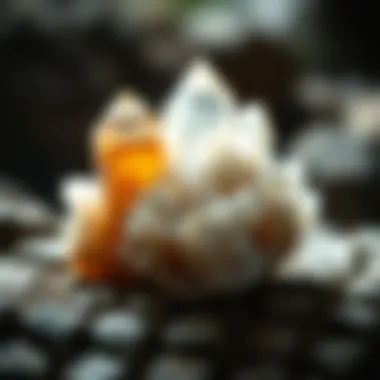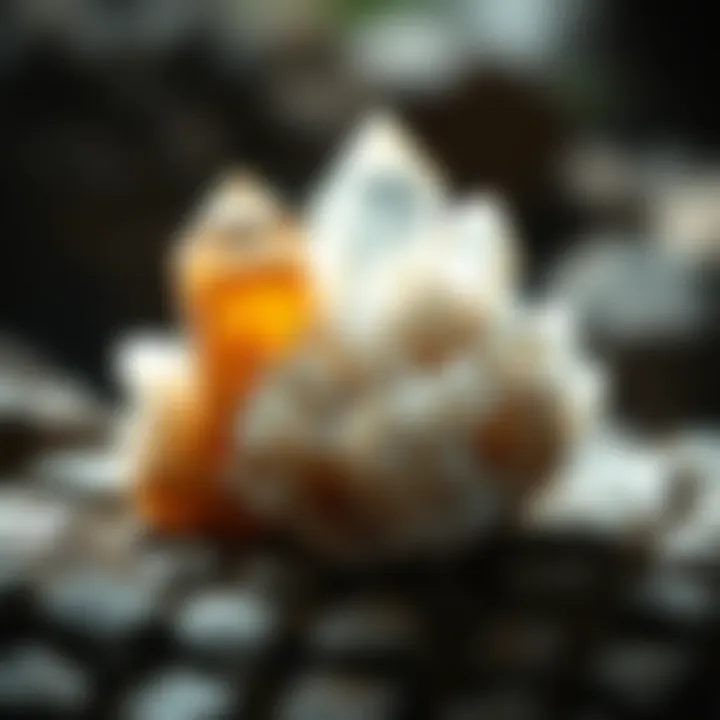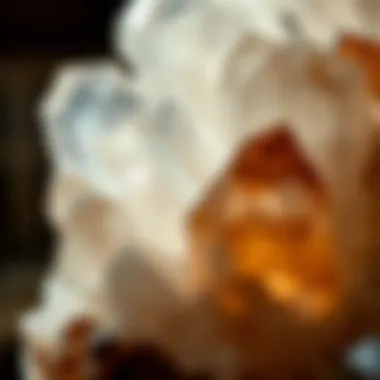A Comprehensive Guide to Crystal Names and Their Significance


Intro
In a world that is constantly evolving, the fascination with crystals remains an enduring thread that ties the past to the present. Crystals have been cherished across centuries, serving not only as decorative pieces but also as symbols steeped in lore and significance. For enthusiasts and collectors alike, grasping the names and meanings behind these stunning natural wonders adds a layer of depth to their pursuit. This guide is designed to illuminate the various aspects of crystals, from their historical backgrounds to their classification, ensuring that you are well-equipped to appreciate and converse about them.
History and Origins
The journey of crystals stretches back to ancient times when they were revered for their supposed mystical properties. Different civilizations cultivated a rich tapestry of stories around specific crystals, attributing various meanings based on their appearances and supposed energies.
Overview of Collectibles, Rocks, and Fossils
Crystals are not merely geological formations; they are collectibles that inspire devotion. The world of rock and fossil collecting is vast and varied. Many individuals dive into this hobby to forge connections with history and nature. Collectors often look for crystals that can tell a story or hold a rarity.
- Some popular crystals among collectors include quartz, amethyst, and tourmaline,
- Each variable in the composition, size, and color can significantly affect a crystal's value and appeal.
What steps can you take to immerse yourself in the world of crystals? Start by establishing a keen eye for detail, and learn about their physical attributes, such as transparency, luster, and hardness.
Historical Significance and Cultural Impact
Throughout different eras, crystals have been significant in both mystical and practical realms. For instance, ancient Egyptians adorned their tombs with lapis lazuli, which was believed to promote protection in the afterlife. Similarly, the use of amethyst in sacred rituals whispers secrets of balance and clarity.
"Crystals are the Earth’s way of grounding us back to the elements; they are as much a part of human history as civilization itself."
Collectors today may find themselves not merely acquiring rocks but stepping into the shoes of those who once valued them for much more than aesthetics. Many educators and enthusiasts encourage remembrance of these historical narratives, which enriches the connection one feels to the stones.
Identification and Classification
The sheer diversity of crystals makes identification paramount for collectors. Understanding the classification of crystals can help you navigate through markets, museums, and geological displays.
Guide to Identifying Rocks and Fossils
Identifying crystals involves a nuanced approach, often requiring focus on specific characteristics, such as:
- Color: While some crystals are monocolored, others exhibit intricate patterns.
- Shape: From cluster formations to intricate geodes, the shape can offer insights into the crystal's formation process.
- Hardness: The Mohs scale is often employed as a reference for gauging mineral hardness.
Familiarity with tools like a magnifying glass and a hardness kit can be incredibly beneficial for collectors aiming to classify crystals accurately.
Common Types and Variations
Knowing the common types of crystals aids collectors in making informed purchases. Some of the notable crystals include:
- Quartz: Celebrated for its clarity and versatility, often used in jewelry.
- Rose Quartz: Associated with the heart chakra, beloved for its gentle pink hue.
- Obsidian: A volcanic glass known for its sharp edges and protective qualities.
Each of these crystals boasts various variations that can be valued differently in the market, depending on factors such as rarity, location, and historical significance.
Crystals hold mysteries waiting to be uncovered. Whether as collectors or casual admirers, engaging with these earthly treasures enhances our appreciation for the natural world and its historical narratives. To learn more about the captivating world of crystals, you might explore resources like Wikipedia, or Britannica.
Delve into the world of crystals, and let your curiosity be your guide. Happy collecting!
Intro to Crystals
Crystals have intrigued humanity for millennia, representing more than just stunning natural formations. They offer a unique intersection of beauty and utility, from crafting functional tools in ancient times to embodying spiritual significance in modern practices. Understanding crystals extends beyond superficial attraction; it unveils their roles in various fields such as geology, metaphysics, and culture. This article seeks to illuminate these multifaceted dimensions, guiding enthusiasts and collectors alike through the intricate world of crystal nomenclature and significance.
Defining Crystals
At their core, crystals are solid materials whose atoms are arranged in highly ordered structures. This orderly arrangement engenders distinctive physical properties — a major reason they are sought after in diverse applications. For instance, quartz crystals, characterized by their hexagonal form, hold a special place in technology due to their piezoelectric properties, which are pivotal in oscillators used in watches and radios.
Crystals can be broadly classified into two categories: mineral crystals, which occur naturally, and synthetic crystals, produced through laboratory processes to mimic their natural counterparts. Each type carries its own set of implications, both scientifically and in the realm of spirituality, where certain crystals are believed to emit energetic frequencies capable of influencing physical and mental well-being.
Historical Context of Crystals
The historical tapestry of crystals is woven through civilizations, each attributing unique meanings and uses to these formations. Ancient Egyptians revered lapis lazuli, often associated with the heavens, embedding it in jewelry and burial artifacts to ensure protection in the afterlife. Similarly, the Greeks identified amethyst as a talisman against intoxication, employing it to ward off drunkenness.
In the East, traditions like Feng Shui still prioritize crystals, believing they can attract positive energy when placed strategically within living spaces. The Romans, on the other hand, viewed crystals as symbols of status, often flaunting them in their ornate jewelry.
"Crystals have transcended the boundaries of science and spirituality, serving as bridges between cultures across eras."
Crystals played roles in healing, decoration, and ceremonial practices throughout history, suggesting that their importance is deeply ingrained in human civilization. As we move forward in this guide, it will become increasingly clear how these historical nuances shape contemporary perceptions and uses of crystals today.
Nomenclature of Crystals
Understanding the nomenclature of crystals offers a vital lens through which we can appreciate and understand these remarkable natural formations. This segment digs deep into how crystals are named and categorized, which not only aids in communication among collectors and scholars but also enhances the clarity and understanding of their unique properties and historical significance. The naming conventions and categorizations bridge the often technical world of geology with the more accessible realm of metaphysics and personal use. Without a solid grasp of nomenclature, one might miss the nuances that define each crystal's identity and value.


Scientific Naming Conventions
Scientific naming conventions for crystals stem from a blend of their mineralogical composition and crystal structure. This systematic approach is known as binomial nomenclature, a practice that classifies crystals using a two-part name format, often derived from Latin or Greek roots.
For example, the well-known mineral Quartz is scientifically classified as SiO₂, representing its silicon dioxide composition. On the other hand, minerals like Calcite belong to the family of carbonates and are identified with the formula CaCO₃. These nomenclatures are not just arbitrary labels; they convey critical information about the crystal's chemical structure, behavior, and potentially its uses.
When delving deeper, one may find that these conventions also incorporate characteristics such as
- Physical Properties: including hardness, luster, and color.
- Geological Context: such as where and how it forms, helping to connect collectors with the geological stories behind their crystals.
By adhering to these conventions, scientists can maintain clarity and specificity in their conversations about various crystals, ensuring that even the most obscure varieties are recognized and respected in the community.
Commonly Used Names Versus Scientific Names
In the arena of crystal collecting, the divide between commonly used names and scientifically accurate names often brings forth an interesting set of challenges. Many collectors might be more familiar with what are essentially nicknames. For instance, while a collector may refer to Amethyst, their scientific designation, Purple Quartz, may not roll off the tongue quite as easily.
This discrepancy can lead to misunderstandings, particularly among novice collectors who may be unaware of the scientific classifications. Understanding the common names alongside their scientific counterparts can greatly enhance a collector's ability to gather accurate information about their specimens.
- Common Names: They often evoke the crystal’s most striking characteristic, like Rose Quartz, named for its delicate pink hue.
- Scientific Names: More technical, these often obscure the crystal’s aesthetic qualities but provide clear insight into its geological identity—Rosé Quartz in this sense could evoke a lovely image without delivering its true identity.
Importantly, using both names interchangeably in conversation can enrich discussions by providing context. Specificity in discussions about crystals helps ensure that everyone is on the same page—whether discussing healing properties with a friend or engaging in rigorous academic study.
"A rose by any other name would smell as sweet," but when it comes to crystals, knowing both names can make all the difference in understanding their true nature.
As rock and fossil collectors, being able to navigate through the intricacies of nomenclature empowers more informed, insightful, and meaningful discussions in both casual and professional contexts.
Popular Crystal Types
Understanding popular crystal types is crucial for enthusiasts and collectors alike. Each crystal embodies distinct properties, resonances, and historical contexts that make them not just beautiful but also significant in various practices. Below, we explore a selection of standout crystals that are often incorporated into collections, detailing their benefits, characteristics, and uses.
Quartz
Quartz is possibly the most abundant crystal on Earth, and it comes in various forms, from clear to smoky. Recognized for its piezoelectric properties, quartz can store and emit energy. This means that it's often used in technology, such as watches and computers.
However, beyond its industrial applications, quartz is lauded within metaphysical communities for its ability to amplify energy and intention. Practitioners often use quartz to enhance meditation and clarity, and it's known as a "master healer" among many crystal aficionados.
In a more practical sense, quartz is also fairly accessible and affordable, making it a popular choice for beginners venturing into crystal collection. To truly experience what quartz has to offer, one could consider incorporating it into daily practices.
Amethyst
Amethyst is a purple variety of quartz that gets its signature color from iron impurities and exposure to radiation over millions of years. It’s often described as an intuitive stone, well-regarded for its calming effect that promotes tranquility and peace.
Many believe amethyst facilitates spiritual growth and and psychic development. It’s frequently recommended for those dealing with anxiety or emotional upsets. Some enthusiasts even place a piece under their pillow to encourage lucid dreams or restful sleep.
Amethyst can also balance one's energy and serve as protection against negative influences. Its beautiful violet hue adds to the visual appeal, making amethyst a sought-after addition to any collection.
Rose Quartz
Often referred to as the "love stone", rose quartz is celebrated for its gentle, nurturing energy. Its soft pink hue symbolizes unconditional love, compassion, and kindness. Collectors often choose rose quartz not only for its beauty but also for its reputed ability to promote self-love and connection with others.
This crystal is particularly favored for use in both romantic and platonic relationships. Many people keep rose quartz in their homes or carry it with them to foster a more loving atmosphere in their surroundings.
Rose quartz can also be useful in emotional healing, encouraging forgiveness and the release of anger. In a world that often feels harsh, this crystal provides a comforting presence, reminding us of the importance of love.
Obsidian
Obsidian is a unique volcanic glass with a glossy appearance, formed from rapidly cooling lava. It has no crystalline structure, making it an interesting specimen for collectors. Obsidian is often black but can also be green or brown depending on the presence of additional minerals.
In the realm of metaphysics, obsidian is thought to have protective qualities, shielding individuals from negative energy and psychic attacks. It's also a grounding stone that aids in emotional healing. Many practitioners use obsidian to delve into the deeper aspects of one’s psyche, encouraging self-discovery by bringing hidden issues to the surface.
This stone is a favorite among collectors who appreciate its aesthetic appeal and rich, intriguing history. Notably, it has also been used throughout history for tools and weapons, adding to its cultural significance.
In summary, each popular crystal type encapsulates a treasure trove of history, properties, and uses. From regulating energy with quartz to safeguarding spirit with obsidian, understanding these diverse crystals can significantly enrich one's collection and personal practices.
The Role of Crystals in Metaphysics
The significance of crystals in the metaphysical realm has fascinated humans for centuries. Many believe that these natural formations are more than just visually appealing objects; they embody energies capable of influencing one's physical and emotional state. This part of the article delves into how different crystals are thought to impact health and well-being, their vibrational energies, and their associations with the body's chakra system.
Healing Properties
Crystals have long been touted for their alleged healing properties. Individuals frequently claim that specific stones can aid in both physical and emotional healing. For instance, amethyst is often thought to promote calmness and mental clarity, while citrine is associated with happiness and abundance. Just as one might turn to herbal remedies for ailments, many enthusiasts rely on crystals, believing them to harness innate restorative powers.
Some commonly believed healing properties of certain crystals include:


- Clear Quartz: Often referred to as the "master healer," this stone is believed to amplify energy and thought. It’s used to help with clarity and focus.
- Rose Quartz: Known for its gentle energy, it is often used for emotional healing, promoting love and compassion.
- Black Tourmaline: Valued for its ability to ward off negative energies and foster grounding, it's often recommended to individuals feeling overwhelmed or anxious.
These claims may stem from the holistic beliefs that body, mind, and spirit are interconnected, and that the right crystal can create a balance that fosters healing. While scientific backing for these assertions may be scant, the rituals surrounding crystal use — such as meditation or intention setting — can provide psychological comfort and encouragement.
Energetic Frequencies
Every crystal emits its unique energetic frequency, which can interact with the energies surrounding us. This idea posits that everything in the universe, including human beings, is made of energy. The notion here is that certain vibrations from crystals might resonate with our energy fields, potentially promoting a shift in balance or improved well-being. Crystals can sometimes be likened to tuning forks, helping to recalibrate one's energy in alignment with the environment or self.
The concept of energetic frequencies can be illustrated through a few examples:
- Selenite is often used for its purported ability to clear blocked energies and promote a serene atmosphere.
- Lapis Lazuli is commonly associated with enhancing intuition and stimulating intellectual ability through its distinct vibrational interplay.
Utilizing crystals to tap into these energetic frequencies often involves deliberate practices, such as placing stones around workspaces or during meditation, encouraging individuals to connect with the energies they wish to attract or amplify.
Chakra Associations
The ancient belief in a system of chakras — energy centers within the body — intertwines significantly with the use of crystals in metaphysical practices. Each chakra is thought to correlate with specific physical and emotional attributes, and many crystals are linked to these energy points. For example, some practitioners might use specific stones to activate or balance particular chakras, fostering overall well-being.
Here’s a concise overview of chakra associations with crystals:
- Root Chakra: Grounding crystals, like red jasper, are believed to stabilize the base chakra, connecting the individual to the earth's energy.
- Heart Chakra: As mentioned earlier, stones like rose quartz can enhance love, compassion, and emotional healing.
- Crown Chakra: Crystals like clear quartz and amethyst are often employed to enhance spiritual connection and higher consciousness.
By consciously aligning crystals with chakra work, individuals aim to enhance personal growth, transformative practices, and the overall experience of holistic health.
“Each crystal, a silent guardian of ancient wisdom, reveals its tale through its unique vibrational essence.”
In summary, the exploration of crystals within the metaphysical domain serves as a rich tapestry, woven with history, holistic beliefs, and personal journeys. As more individuals turn to these natural treasures for assistance in navigating the complexities of life, the role of crystals in metaphysical practices remains a profound and compelling subject.
Crystals in Geology
Crystals play a critical role in geology, not just as beautiful specimens admired by collectors but also as key indicators of geological processes and environmental conditions. Understanding the formation and classification of crystals provides important insights into Earth’s history and structure. For rock and fossil collectors, knowledge of this aspect can deepen appreciation for the diversity and complexity of geological formations. The study of crystals in geology encompasses two main concepts: formation processes and mineral classification.
Formation Processes
The formation of crystals is a fascinating journey that tells the story of geological conditions over time. They can form in several ways, each influenced by temperature, pressure, and the chemical composition of the surrounding environment. Here are the primary processes:
- Cooling and Crystallization: Many crystals form from molten rock or magma. When magma cools, it gradually solidifies and the minerals crystallize. This process can take place underground over thousands of years, leading to the formation of igneous rocks like granite, which can have large, eye-catching quartz crystals.
- Metamorphism: Under certain conditions of temperature and pressure, existing rocks undergo a metamorphic process, resulting in new crystalline forms. For example, limestone may transform into marble, with calcite crystals developing as a result.
- Evaporation: In environments where water evaporates rapidly, such as salt flats or shallow seas, dissolved minerals crystallize out of the solution. This process produces crystals of halite, gypsum, and other evaporate minerals, which hold significant economic value.
- Biomineralization: Certain organisms produce crystals as part of their biological processes. For instance, mollusks create calcium carbonate shells through biomineralization, leading to interesting crystal structures that are useful for paleontological studies.
These processes not only create crystals that are stunning to behold but also speak volumes about Earth’s dynamic systems. Understanding the nuances of how these crystals form can help collectors appreciate the unique stories each specimen carries.
Mineral Classification
Classifying crystals involves grouping them based on their mineral compositions and structures. This classification is essential for both geologists and collectors to understand the characteristics and potential applications of different crystals. Some commonly recognized categories include:
- Silicates: Making up about 90% of the Earth's crust, silicates include minerals like quartz and feldspar. They are defined by the presence of silicon and oxygen.
- Carbonates: Composed of carbonate ions, these minerals include calcite and dolomite. They are often formed through biological processes or through the evaporation of water.
- Oxides and Hydroxides: Minerals like hematite and gibbsite fall into this category. They are important for understanding ore deposits and are commonly sought after in mineral collecting.
- Sulfides: This group includes mineral forms like pyrite and galena. They are often associated with metal deposits and can be significant economically.
"Understanding the classification of minerals not only enhances one’s collection but also informs about the conditions under which they formed, providing deeper insights into Earth’s makeup."
Mineral classification systems such as the Strunz Classification or the Dana Classification help in systematically categorizing crystals. For collectors, being familiar with these classifications can aid in identification and valuation of specimens. Online resources for crystal classification can be found on sites like Wikipedia or Britannica.
With the knowledge of formation processes and mineral classification, rock and fossil collectors can gain a richer understanding of the natural world. This understanding not only fosters a deeper appreciation for the beauty of crystals but also encourages a greater respect for the Earth’s environment.
Cultural Significance of Crystals
Crystals have held a significant role in various cultures throughout history. They are not mere geological formations; they embody meanings and values that reflect the philosophies and beliefs of different peoples. Understanding the cultural significance of crystals deepens our appreciation of them in both historical and contemporary contexts. It also sheds light on why certain crystals are treasured while others are overlooked. By recognizing their symbolic and practical uses, collectors and enthusiasts can better connect with these natural wonders, enhancing both their collection and personal experiences.
Crystals in Ancient Civilizations
Historically, crystals were much more than decorative pieces; they were thought to hold profound spiritual and earthly powers. In ancient Egyptian culture, for instance, lapis lazuli was highly esteemed. It wasn't just valued for its vivid blue color but was believed to facilitate communication with the divine. Pharaohs adorned themselves in lapis, hoping to harness its power in the afterlife.
Similarly, the use of amethyst in ancient Greece was widespread. Greeks associated it with Bacchus, the god of wine. They believed that wearing amethyst could prevent drunkenness and promote clarity of thought. This shows how deeply intertwined crystals were with the daily lives and rituals of these civilizations.
- Key Crystals in Ancient Cultures:
- Lapis Lazuli: Spiritual connection and protection
- Amethyst: Clarity and sobriety
- Obsidian: Used for tools and protective amulets
In China, jade has been admired for its beauty and its significance in embodying virtues like wisdom and righteousness. The Chinese often referred to jade as a "soft stone, powerful as the sun." It is common to see jade crafted into ornaments and used in rituals, reflecting its sacred status.
"A precious stone recognized not only for its beauty but also for its ability to bridge the earthly and the mystical realms."
Crystals like quartz, known to many as a "master healer," were also a part of ancient practices. These stones were thought to amplify energy and enhance spiritual connectivity. This connection to the earth and spirit transcends cultures and continues to resonate in modern times.


Modern Spiritual Practices
In today's world, crystals have seen a resurgence, especially within spiritual and healing communities. Many people hold the belief that these stones possess unique energy signatures that can influence mental, physical, and emotional states. This is not limited to any single practice; various spiritual groups integrate crystals into their rituals and healing processes. For instance, practitioners of Reiki often use rose quartz for its purported ability to foster love and compassion, while psychics might employ clear quartz to heighten their intuitive powers.
Benefits of Using Crystals in Modern Spirituality:
- Healing Properties: Many believe crystals can promote well-being and facilitate healing.
- Meditative Focus: Crystals are often used as focal points during meditation, helping to enhance concentration.
- Manifestation Tools: Certain stones are believed to help manifest personal goals and desires.
Crystals have found a place in meditation and yoga practices as well. For example, selenite is often used to create a peaceful environment, aiding in relaxation during yoga sessions. People have incorporated crystal grids into their spaces to create harmonious energy flows that support mindfulness and clarity.
Interestingly, social media platforms like Instagram and Reddit have become modern-day forums for sharing experiences and knowledge about crystals. Users discuss their personal stories and practices in various communities, often recommending specific crystals for certain ailments, insecurities, or aspirations.
Collectively, these practices reveal a blend of ancient wisdom and modern insights.
As we navigate our busy lives, reconnecting with nature through these stones offers a reminder of continuity in human experience, linking us back to our ancestors while also providing avenues for personal growth and enlightenment.
Collecting Crystals
Collecting crystals is more than just a hobby; it is a passionate pursuit that intertwines beauty, science, and history. For many rock and fossil collectors, the allure of crystals stems from their diverse forms and remarkable properties. The act of gathering these natural treasures can provide deep personal satisfaction, as well as a greater appreciation for the Earth's geological processes. Let's delve deeper into the valuation of crystals and the importance of ethical sourcing in the crystal collecting community.
Valuation of Crystals
Valuing crystals involves more than just assessing their visual appeal. A myriad of factors contribute to the worth of a crystal specimen, and collectors must sharpen their skills to navigate this complex landscape. First and foremost, the quality of the gemstone plays a significant role.
- Clarity: The clearer a crystal is, the more valuable it typically becomes. Imperfections or inclusions can detract from the stone's beauty and thus its price.
- Color: Vibrant, saturated colors are often more prized than those that are muted or washed out. Gemstones like emerald or sapphire exemplify this principle; the depth of their color can dramatically influence their market value.
- Cut and Shape: The way a crystal is cut can impact its brilliance and overall look. High-quality cuts enhance the stone’s ability to reflect light effectively, increasing its desirability.
- Rarity: Some crystals are rare and hard to come by, which vaults their worth skyward. For instance, a natural diamond is valued far more than a common quartz, given its scarcity.
Understanding these elements is crucial for any collector. Not only does it enable one to make informed purchasing decisions, but it also aids in the appreciation of one’s existing collection. As you assess your specimens, consider keeping a detailed record that includes the origin, sale price, and any notable characteristics.
"Knowledge is the bedrock of successful collecting."
Ethical Sourcing
In recent years, the conversation surrounding ethical sourcing in the crystal market has gained momentum. Collectors are becoming increasingly aware of the environmental and social impacts of their purchases. Ethical sourcing ensures that crystals are obtained responsibly, which not only protects the environment but also supports local communities. Here are several key considerations for collectors:
- Environmental Impact: Collecting gemstones from environmentally damaging practices can lead to habitat destruction and pollution. When acquiring crystals, seek out suppliers who prioritize sustainable mining techniques.
- Community Support: Many mining communities rely on the crystal trade for their livelihoods. Engaging with vendors who support fair labor practices and local economies can make a significant difference.
- Certification: Some crystals come with certificates that validate their ethical sourcing. Look for gems that are labeled as conflict-free or from reputable dealers who provide documentation of their sourcing practices.
By choosing to buy from ethical sources, collectors not only enhance the value of their collections but also contribute positively toward the future of the gem and mineral industry. A conscientious approach to crystal collecting can illuminate the path toward a more sustainable and responsible community.
Care and Maintenance of Crystals
Maintaining the aesthetic and metaphysical qualities of crystals is as important as selecting them in the first place. Proper care and maintenance of crystals extend their life, enhance their qualities, and preserve their stunning appearance. Crystals are not just decorative items; they are repositories of energy and potential that resonate with those who appreciate their properties, whether for decoration, healing, or spiritual enhancement. Neglecting to care for them can lead to diminished energies and an uninviting look that undermines their inherent beauty.
Cleaning Techniques
When it comes to cleaning crystals, not every approach suits all types. The material composition of a crystal determines the best method for keeping it pristine. Here are some commonly used techniques:
- Water Rinsing: Some crystals, like quartz, can handle a simple rinse under lukewarm running water. This method removes any physical debris and restores a bit of vitality. Care should be taken to ensure the water doesn't erode delicate structures.
- Salt Cleaning: For tougher grime, a saltwater soak is effective. Dissolve natural salt (like sea salt) in water and let your crystals soak for a few hours. Always ensure that your crystal type is resistant to salt, as some can be damaged.
- Smudging with Sage: A culturally rich method involves the use of sage for smudging. This practice not only cleanses the crystal of physical dirt but also clears it of negative energies. Light the sage and allow the smoke to envelop the crystal briefly.
- Sound Bathing: Using sound waves is an innovative technique. Crystal singing bowls or Tibetan bells can be used to cleanse crystals by placing them nearby while the sounds resonate. This is ideal for those looking to recharge their spiritual qualities.
Cleaning crystals regularly can help facilitate their metaphysical benefits and ensure they remain a source of positive energy and beauty in your collection.
Storage Solutions
Where you store your crystals also significantly influences their longevity and effectiveness. Keeping crystals organized and secure helps prevent damage from environmental conditions or unintentional breakage. Here are some strategies for optimal crystal storage:
- Soft Linings: Use a cushioned box, like those lined with soft fabric, to prevent scratches and chips. This offers a protective barrier against other minerals that may be harder.
- Separation: Storing different types of crystals separately can prevent them from clashing energetically or physically. Using small bags, like those made of velvet or silk, to wrap each crystal keeps their individual energies intact while providing additional cushioning.
- Dry Conditions: Crystals should be stored in a dry, cool environment. Humidity can lead to damage, especially for more delicate crystals. Finding a dark, cool cabinet is often ideal.
- Labeling: Consider labeling your crystals if you have a large collection. This not only makes it easier to find specific ones but also adds an element of organization, preventing accidental misplacement or damage.
With attentive care and thoughtful storage solutions, collectors can preserve the beauty and integrity of their crystals while enhancing their energetic properties. Those dedicated to the collection of these natural marvels will find that a little effort goes a long way in maintaining their stunning allure and spiritual significance.
The Future of Crystal Collecting
As we move forward into a new realm of awareness and appreciation for crystals, the practice of collecting these natural wonders is evolving in fascinating ways. The future of crystal collecting is not just about accumulating beautiful specimens; it’s about understanding their roles within larger ecosystems and societal structures. Collectors today are becoming more discerning and conscientious, leading to a significant shift in how we approach these stones.
This section aims to illuminate the emerging trends and the technological advancements that are setting the stage for a new chapter in crystal collecting. It emphasizes the importance of ethical considerations and sustainability, highlighting the benefits of awareness in making informed choices about crystal acquisitions.
Emerging Trends
The landscape of crystal collecting is seeing flurries of change, driven by a new generation of enthusiasts. These collectors are not only passionate about the beauty of minerals but are increasingly attuned to their origins and the environmental impacts of mining practices. Some notable trends include:
- Sustainability Focus: Many collectors are gravitating towards ethically sourced crystals. Knowledge about where and how these stones are obtained is paramount.
- Holistic Approaches: Crystals are being recognized as tools for wellness and spiritual growth, leading to a surge in interest in crystals' metaphysical properties.
- Online Communities: The social media boom has propelled crystal collecting from niche forums into mainstream discussions. This has created networks for sharing knowledge, trading, and selling crystals.
Collectors now treat crystals not only as items of beauty but as sources of knowledge about our planet and our own spiritual journeys.
Technological Advances in Identification
Alongside the shift in collecting practices, technology is playing a vital role in how these natural treasures are identified and authenticated. With advancements in geology and mineral science, new tools and techniques have emerged. These technical innovations are creating more precise and reliable methods for identifying crystals:
- Spectroscopy: This technique allows for detailed analysis of crystals, providing information about composition and potential treatments. It helps collectors ensure they are buying authentic pieces without unnecessary enhancements.
- Digital Databases: With an explosion of information online, databases are being developed that compile vast amounts of data on mineral properties, helping collectors identify stones on the go.
- 3D Imaging: The use of 3D technology provides models of crystals that can further assist in education and exhibition, making knowledge more accessible to the public.
The future certainly looks promising for crystal collectors, driven by advancements in technology and a collective commitment to ethical practices. Collectors can look forward to a vibrant community that not only values beauty but also environmental consciousness. As this field continues to evolve, staying updated on trends and technological intricacies is key for any dedicated enthusiast.



